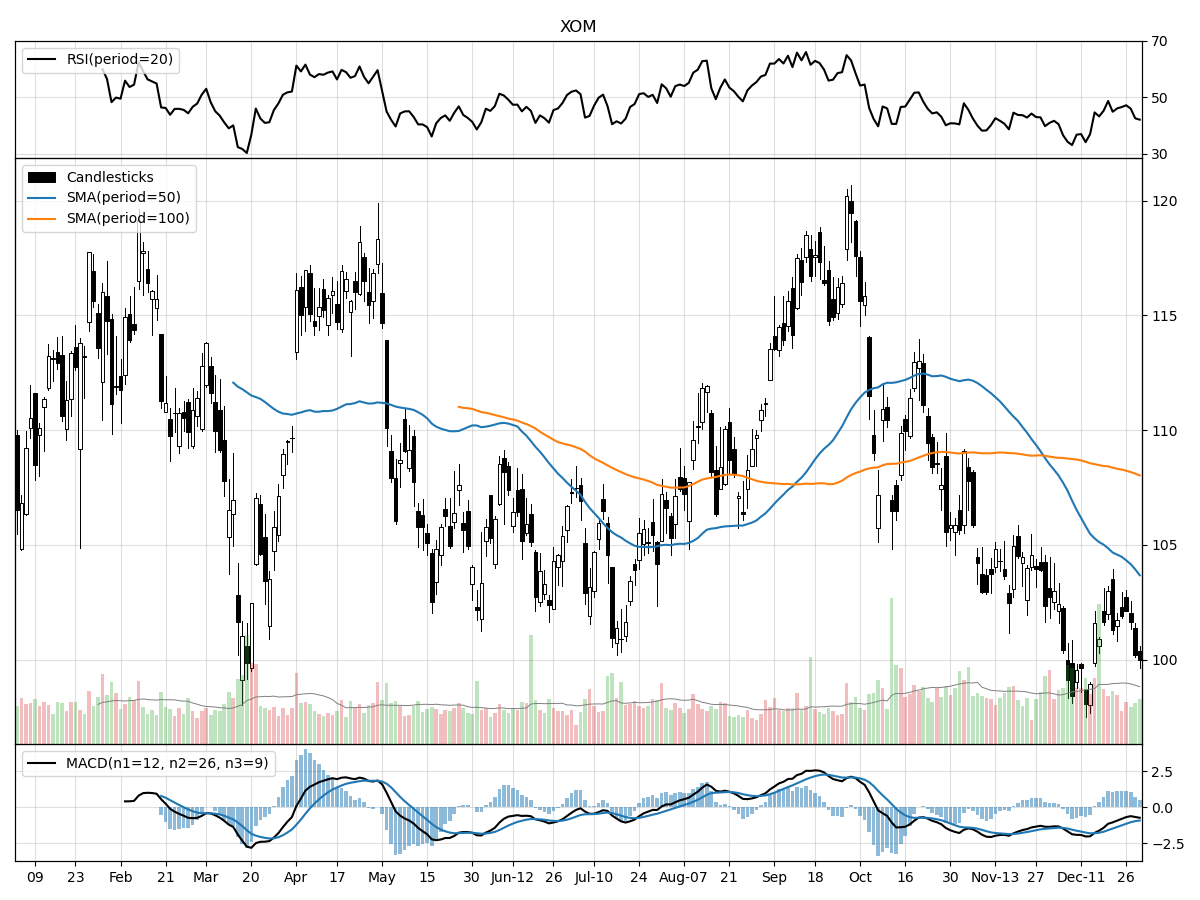Exxon Mobil Corporation (XOM), Large Cap AI Study of the Week

January 2, 2024
Weekly AI Pick from the S&P 500
Exxon Mobil Corporation (XOM)
Company Overview
Exxon Mobil Corporation is a major player in the global oil and gas industry, with a history dating back to 1882. The company is involved in the exploration and production of crude oil and natural gas, as well as the sale of petrochemical products. Furthermore, ExxonMobil is investing in low-emission energy technologies, including carbon capture and hydrogen, to adapt to the changing energy landscape that emphasizes emission reduction. Operating under well-known brand names such as Exxon, Mobil, and Esso, ExxonMobil faces stiff competition in the international energy and petrochemical sectors.
The company holds over 8,000 active patents and earned approximately $129 million from technology licensing in 2022, although no single technology dominates its profitability. ExxonMobil values its human capital, boasting a diverse workforce with an impressive average tenure of 30 years, representing over 160 nationalities. Looking forward, ExxonMobil is committed to increasing its environmental expenditure, planning to allocate $7.3 billion in 2023 and $8.2 billion in 2024 towards clean energy initiatives and emissions reduction, in compliance with stringent environmental regulations. This investment reflects ExxonMobil's strategic shift towards sustainability while maintaining its core business operations.
By the Numbers
- Upstream segment earnings decrease: Impact of lower natural gas and crude oil prices resulted in a $5,690 million negative impact.
- Upstream segment loss from identified items: $(2,378) million for 2022 and $(184) million for 2023.
- Oil-equivalent production: Stable at an average of 3.7 million barrels per day.
- Energy Products segment earnings decline: Decrease by $2,970 million due to weaker refining margins and unfavorable trading impacts.
- Refinery throughput: Marginal year-over-year increase.
- Chemical Products segment earnings drop: Down to $249 million from $812 million the previous year.
- Chemical Products segment year-to-date earnings decrease: By $1,060 million.
- Specialty Products segment: Decrease in third-quarter earnings but increase in year-to-date earnings.
- Corporate and Financing expenses: Increase contributing to a larger year-to-date loss compared to the previous year.
- Cash flow from operations and asset sales: Decreased to $16.9 billion in the third quarter.
- Net cash from operating activities: Decrease for the first nine months.
- Investment in property, plant, and equipment: Increased by $3.1 billion.
- Shareholder distributions: $11.1 billion through dividends and share repurchases.
- Net debt to capital ratio: Slight improvement.
- Long-term sales and purchase commitments: Estimated obligations of approximately $6.9 billion.
- Lease commitments: Totaling $6.3 billion.
- Taxes paid in the third quarter: Increased slightly to $12.8 billion.
- Income taxes: Decrease to $4.4 billion.
- Effective tax rate: Rose to 34%.
- Capital and exploration expenditures: $6.0 billion in the third quarter, projected up to $25 billion for the year.
- Potential transactions: With Pioneer Natural Resources and Denbury Inc., subject to SEC filings and proxy solicitations.
- 2030 emission reduction goals: Incorporated into business plans, but future environmental statements are not guaranteed to be material to investors.
Stock Performance and Technical Analysis

The technical analysis of a stock often involves examining various indicators that can provide insights into the stock's momentum, trend, and potential reversal points. Based on the current technicals provided, it seems that the stock is trading close to its 52-week low, at just 1 percent above it, and is 16 percent below its 52-week high. This presents a mixed picture; on one hand, it could indicate that the stock has potential for a rebound if it has been oversold, but on the other hand, the proximity to its low suggests caution as it might indicate an ongoing negative sentiment or fundamental issues with the company.
The trading volume is another important factor to consider. The recent daily volume is higher than the longer-term average, which could signify increased interest in the stock. However, without additional context, it's hard to determine if this interest is from buyers accumulating shares or sellers distributing them. The Money Flow indicators suggest that the stock is under moderate selling pressure and is undergoing distribution, which means that more investors are looking to sell their shares than to buy, potentially driving the price down. The MACD (Moving Average Convergence Divergence) being bearish at -0.92 reinforces this negative outlook, as a bearish MACD indicates that the short-term momentum is weaker than the long-term momentum, suggesting that the stock could continue to trend downwards.
In the last three months, the stock has fallen by over 8%, and despite price stability in the last month, the overall trend seems to be negative. The bearish MACD and the Money Flow indicators pointing to distribution suggest that there may be a continued downward pressure on the stock price. Investors should proceed with caution, considering both these technical indicators and any fundamental analysis, including recent news, earnings reports, and sector performance, before making an investment decision. It is also essential to consider risk tolerance and whether the stock fits within one's portfolio strategy. If an investor is looking for a potential turnaround story, it might be worth watching for any bullish signals or improvements in fundamentals before initiating a position.

The ‘Bull’ Perspective
Exxon Mobil Corporation (XOM): A Bullish Investment Outlook
Summary:
- Robust Financial Performance: Despite the mixed results in the latest 10-Q report, Exxon Mobil has demonstrated resilience with a stable oil-equivalent production of 3.7 million barrels per day and continued shareholder value through significant dividends and share repurchases.
- Strategic Investments and Developments: Capital and exploration expenditures are on the rise, with up to $25 billion projected for the year, signaling confidence in future growth, particularly from new developments in Guyana and the Permian Basin.
- Improving Industry Fundamentals: The easing of inflation and the Fed's pivot on interest rates bode well for the oil and gas industry, potentially reducing operational costs and improving the economic environment for Exxon Mobil's products.
- Diversified Portfolio and Innovation: Exxon Mobil's investment in lower-emission technologies and carbon capture positions the company to navigate regulatory risks and capitalize on the transition to cleaner energy.
- Strong Market Position and Resilience: With a history of weathering economic downturns and market volatility, Exxon Mobil's size, global presence, and strategic focus on efficiency and portfolio management make it a robust investment option.
Elaboration:
- Robust Financial Performance:
Exxon Mobil's financial performance has been a testament to its operational excellence and ability to navigate market fluctuations. While the latest quarterly report shows some segmental downturns, the company's overall oil-equivalent production has remained stable. This stability is crucial in an industry known for its volatility. Moreover, Exxon Mobil continues to prioritize shareholder returns, distributing $11.1 billion through dividends and share repurchases, showcasing its commitment to delivering value. The improved net debt to capital ratio, even with increased investments, illustrates Exxon Mobil's sound financial management and resilience. - Strategic Investments and Developments:
The company's increased capital and exploration expenditures, up to $25 billion for the year, reflect a strategic focus on growth and long-term value creation. Investments in key areas like Guyana and the Permian Basin are expected to bolster production volumes and drive future profitability. Exxon Mobil's proactive approach to expanding its asset base and enhancing its operational capabilities underscores its potential for sustained growth and its ability to capitalize on market opportunities as they arise. - Improving Industry Fundamentals:
The broader economic context is turning favorable for the oil and gas industry. Disinflationary trends and the potential end of the Fed's tightening cycle could reduce borrowing costs and operational expenses for Exxon Mobil. With the consumer price index moving toward the Fed's 2% target and interest rates poised to stabilize or even decline, the cost of doing business may decrease, improving margins and profitability for Exxon Mobil. Additionally, the stabilization of oil prices below the peaks of recent years could support consumer demand for energy products, benefiting Exxon Mobil's downstream operations. - Diversified Portfolio and Innovation:
Exxon Mobil's strategic investments in lower-emission technologies and carbon capture initiatives position the company at the forefront of the energy transition. This diversification not only mitigates the risk posed by regulatory changes aimed at reducing greenhouse gas emissions but also opens up new market opportunities. The company's commitment to innovation and adapting to climate-related market shifts demonstrates its forward-thinking approach and potential to lead in the evolving energy landscape. - Strong Market Position and Resilience:
Exxon Mobil's robust market position, characterized by its global presence and scale, provides a competitive edge. The company's experience in managing economic downturns and industry-specific challenges equips it to withstand and capitalize on market volatility. Its focus on operational efficiency, staff retention, and portfolio optimization further enhances its resilience. Despite the risks of geopolitical events, currency fluctuations, and natural disasters, Exxon Mobil's comprehensive risk management system and strategic agility make it a compelling investment option.
Conclusion:
In light of the above points, Exxon Mobil Corporation represents a strong investment opportunity with its demonstrated financial resilience, strategic growth investments, favorable industry fundamentals, diversified portfolio, and proven market resilience. The company's ability to navigate risks, commitment to innovation, and consistent shareholder returns provide a solid foundation for bullish sentiment. Investors looking for a robust addition to their portfolio should consider the potential long-term benefits of investing in Exxon Mobil.

The ‘Bear’ Perspective
The Case Against Investing in Exxon Mobil Corporation (XOM)
Summary:
- Vulnerability to Fluctuating Commodity Prices: Exxon Mobil's earnings are highly susceptible to the whims of volatile commodity markets, with a significant impact of $5,690 million due to lower natural gas and crude oil prices.
- Regulatory and Litigation Risks: The company is exposed to stringent environmental regulations and potential litigation, especially in countries with high punitive damages, which could lead to substantial financial liabilities.
- Operational and Geopolitical Challenges: Operational disruptions due to security concerns, civil unrest, or geopolitical tensions can adversely affect the company's global operations, leading to increased costs and reduced output.
- Climate Change Strategy Uncertainties: Exxon Mobil's investment in lower-emission technologies and carbon capture are subject to unpredictable government policies and market reactions, posing a risk to their long-term strategy and capital allocation.
- Financial Performance Pressures: With a decrease in earnings across multiple segments and a significant increase in capital and exploration expenditures, Exxon Mobil's financial performance is under pressure, raising concerns over future profitability.
Elaboration:
- Commodity Price Sensitivity:
Exxon Mobil's financial health is closely tied to the unpredictable nature of global commodity prices. In the past year, the company has felt the sting of this volatility, with its Upstream segment's earnings taking a $5,690 million hit due to declining prices for natural gas and crude oil. This sensitivity to market fluctuations exposes investors to a high degree of risk, as even marginal price movements can have outsized impacts on the bottom line. The company's recent net decrease in earnings, including a loss of $(2,378) million in 2022 and $(184) million in 2023 from identified items, underscores the inherent instability of investing in a commodity-dependent entity. - Regulatory and Litigation Risks:
Exxon Mobil operates in an industry that is increasingly in the crosshairs of environmental regulation and litigation. The company's business model and future projects could be significantly impacted by stringent environmental laws, particularly in jurisdictions like the U.S., where punitive damages can be substantial. The potential financial impacts of compliance costs, fines, and legal settlements are a looming threat to Exxon Mobil's profitability and, by extension, investor returns. This is compounded by the company's need to invest in new technologies and markets, which are themselves subject to a shifting regulatory landscape. - Operational and Geopolitical Challenges:
The company's global footprint exposes it to a variety of operational risks, including civil unrest, sabotage, and geopolitical conflicts that can disrupt supply chains and production. These risks are not merely hypothetical; they have materialized in the past and have the potential to do so again, leading to increased operational costs and reduced output. For example, Exxon Mobil's production averages, such as the 3.7 million barrels per day, could be compromised by any number of these factors, which would negatively affect the company's financial results and investor confidence. - Climate Change Strategy Uncertainties:
Exxon Mobil's response to climate change, including its initiatives in lower-emission technologies and carbon capture, is fraught with uncertainty. The success of these ventures is heavily dependent on government policies that are in flux, as well as market acceptance and technological feasibility. While the company aims to align its business strategy with emission reduction goals, the unpredictable nature of policy and market responses to climate change initiatives presents a substantial risk to the company's long-term investments and strategic direction. - Financial Performance Pressures:
The company's financial performance is showing signs of strain, with decreased earnings across several segments, including a notable decline in the Chemical Products segment from $812 million to $249 million. Additionally, Exxon Mobil has ramped up its capital and exploration expenditures to $6.0 billion in the third quarter, with projections to reach up to $25 billion for the year. This increase in spending, coupled with the aforementioned risks and uncertainties, puts significant pressure on the company's ability to maintain, let alone grow, profitability. Such financial pressures could potentially lead to reduced dividends and share repurchases, both of which are critical factors for investors seeking stable returns.
Conclusion:
Investing in Exxon Mobil Corporation carries a multitude of risks, from the volatility of commodity markets to the uncertainties surrounding climate change strategies and regulatory environments. The company's recent financial performance and increased spending in the face of these challenges further exacerbate the risk profile for investors. Given these considerations, a cautious approach is warranted, and investors may be better served by exploring opportunities in less volatile sectors or companies with more predictable earnings streams.




Comments ()